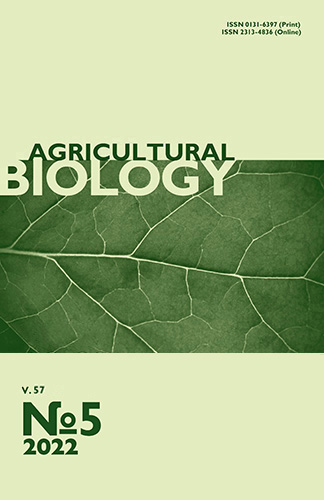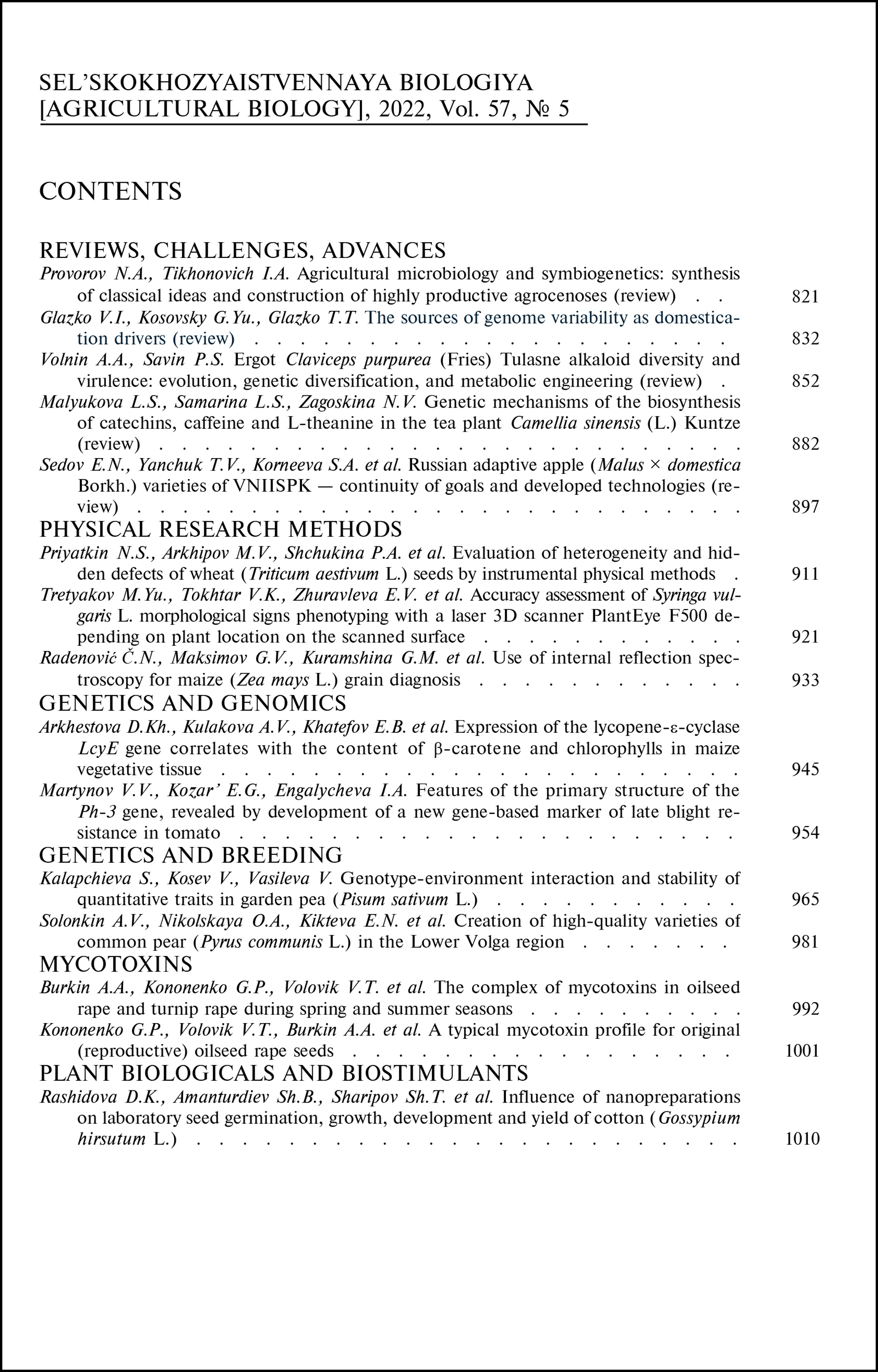doi: 10.15389/agrobiology.2022.5.933eng
UDC: 633.15:577.336
Acknowledgements:
In Serbia, research was funded by the Zemun Pole Maize Research Institute (Belgrade) and the Faculty of Physical Chemistry of the University of Belgrade, as well as the Ministry of Education, Science and Technological Development of Serbia (Projects 03E211, 03E22, TR-20014, Nos. 31028, 31037). In the Russian Federation, research is being conducted under the guidance of Professor G.V. Maksimov and funded by the RSF Project No. 19-79-30062. The study was also supported by the Interdisciplinary Scientific and Educational School of Lomonosov Moscow State University “Molecular technologies of living systems and synthetic biology”.
USE OF INTERNAL REFLECTION SPECTROSCOPY FOR MAIZE (Zea mays L.) GRAIN DIAGNOSIS
Č.N. Radenović1, 2, G.V. Maksimov3 ✉, G.M. Kuramshina4,
V.V. Shutova5, J. Hao6, N.S. Delić1, M.D. Sechanski1,
A.S. Popović1, D.V. Bajuk-Bogdanović2, M.M. Radosavljević1,
J.M. Pavlov1
1Maize Research Institute, Zemun Polje, ul. Slobodana Bajicha 1, 11185 Belgrade-Zemun, Serbia, e-mail radenovic@sbb.rs, ndelic@mrizp.rs, msecanski@mrizp.rs, pkosanic@mrizp.rs, rmilica@mrizp.rs, jpavlov@mrizp.rs;
2University of Belgrade, Faculty for Physical Chemistry, 12-16 Studentski trg, 11000 Belgrade, Serbia, e-mail danabb@ffh.bg.ac.rs;
3Lomonosov Moscow State University, Faculty of Biology, 1-12 Leninskie Gory, Moscow, 119234 Russia, e-mail gmaksimov@mail.ru (✉ corresponding author);
4Lomonosov Moscow State University, Faculty of Chemistry, 1-12 Leninskie Gory, Moscow, 119234 Russia, e-mail kuramshi@phys.chem.msu.ru ;
5Ogarev National Research Mordovia State University, 68, ul. Bolshevistskaya, Republic of Mordovia, Saransk, 430005 Russia, e-mail vshutova@yandex.ru;
6Shenzhen MSU-BIT University, Biology Department,No 299, Ruyi Road, Longgang District, Shenzhen, Guangdong, 518172 China, e-mail haojingrao@126.com
ORCID:
Radenović Č.N. orcid.org/0000-0002-4997-7635
Sechanski M.D. orcidorg/0000-0003-2070-4366
Maksimov G.V. orcid.org/0000-0002-7377-0773
Popović A.S. orcid.org/0000-0002-4569-6799
Kuramshina G.M. orcid.org/0000-0002-4044-471X
Bajuk-Bogdanović D.V. orcid.org/0000-0003-2443-376X
Shutova V.V. orcid.org/0000-0001-6437-3621
Radosavljević M.M. orcid.org/0000-0002-1026-4582
Hao J. orcid.org/0000-0003-4256-5969
Pavlov J.M. orcid.org/0000-0002-0310-1902
Delić N.S. orcid.org/0000-0003-4020-0114
Received June 16, 2022
Infrared (IR) spectroscopy and Raman spectroscopy (RS) are modern methods on the basis of which biotechnological approaches are being successfully developed that allow genetic and functional analysis of individual plant organs and tissues at the molecular level. In the present work, using surface internal reflection spectroscopy (SIR), which is a modification of IR spectroscopy, differences in the content and conformation of biomolecules in grain homogenates and its components (endosperm, pericarp, germ) of ZP 735 maize hybrids were first recorded and revealed. Our goal was to develop a methodology for surface SIR for the identification of organic molecules, their content and conformation in corn seed and its tissues. The grains of the corn hybrid (Zea mays L.) ZP 735 (originator Maize Research Institute, Zemun Polje, Belgrade, Serbia) served as the object of the study. Thirty grains were selected by random sampling. To obtain SIR spectra, samples of grains and their parts (endosperm, pericarp, and embryo) were crushed, homogenized, and placed in a special cell of the device. A spectrometer (FT-IR spectrophotometer, Thermo Scientific, USA) with diamond (diamond ATR crystal, Thermo Scientific, USA) was used to record the SIR spectra, and a software package (Thermo Scientific™ ) was used to analyze the spectra. The SIR spectra were compared in the data library of the Advanced ATR correction Algorithm program. The SIR spectroscopy method is based on the reflection of a light beam at the interface between two phases: the phase of a crystal with a high refractive index, which is part of the SIR device, and the phase of the sample under study with a lower refractive index. During the measurement, the light beam penetrates to a small depth into the phase of the sample, where it is partially absorbed. During subsequent irradiation of the sample, this phenomenon is repeated, and as a result, the SIR spectrum is recorded. It has been proven that in the range from 400 cm-1 to 4000 cm-1 ATR spectra of whole grain, endosperm, pericarp and embryo of the ZP 735 hybrid are similar to the previously obtained IR spectra of grain, which indicates the possibility of using a new method for molecular breeding technologies. The location of the bands of the SIR spectrum characterizes various forms of vibrations of the valence bonds of the functional groups of the organic molecules of the seed, which makes it possible to identify not only the presence of certain molecules, but also their conformation. It has been proved that by analyzing the amplitude of the SIR spectrum bands (maximum intensity amplitude and high intensity amplitude), it is possible to control changes in the content of a number of organic compounds in seed tissues: proteins, lipids, sugars, esters, amides, ketones, aldehydes, carboxylic acids, simple ethers, phenols, alcohols, aromatic hydrocarbons, acyclic compounds, alkenes, alkanes and alkynes. The obtained results are important for testing the presence of the necessary organic compounds in the grain or changes in their conformation during the selection process. The important advantages of SIR spectroscopy compared to IR spectroscopy include, on the one hand, the preservation of the nativeness of the object (the possibility of conducting research without fixing or staining the object) and simple sample preparation, on the other hand, an effective assessment of the content and conformation of molecules with high sensitivity (resolution about 1.0 cm-1). The implementation of the developed methodology for the formation of molecular breeding technology will increase the profitability of cultivation and the efficiency of breeding not only corn, but also other agricultural plants.
Keywords: Zea mays L., hybrid, grain, endosperm, pericarp, embryo, surface internal reflection spectroscopy.
REFERENCES
- Radenović C.N., Maksimov G.V., Tyutyaev E.V., Stanković G.J., Jovanović Z.V., Beljanski M.V. Detecting the phase transition in thylakoid membranes of maize inbred lines by means of delayed fluorescence. Plant Physiology and Biochemistry, 2014, 81: 208-211 CrossRef
- Grubbs B.A., Etter N.P., Slaughter W.E., Pittsford A.M., Smith C.R., Schmitt P.D. A low-cost beam-scanning second harmonic generation microscope with application for agrochemical development and testing. Analytical Chemistry, 2019, 91(18): 11723-11730 CrossRef
- Butler H.J., Martin F.L., Roberts M.R., Adams S., McAinsh M.R. Observation of nutrient uptake at the adaxial surface of leaves of tomato (Solanum lycopersicum) using Raman spectroscopy. Analytical Letters, 2020, 53(4): 536-562 CrossRef
- Hu F., Shi L., Min W. Biological imaging of chemical bonds by stimulated Raman scattering microscopy. Nature Methods,2019, 16(9): 830-842 CrossRef
- Schiavon M., Pizzeghello D., Muscolo A., Vaccaro S., Francioso O., Nardi S. High molecular size humic substances enhance phenylpropanoid metabolism in maize (Zea mays L.). J. Chem. Ecol., 2010, 36 (6): 662-669 CrossRef
- Ertani A., Francioso O., Tinti A., Schiavon M., Pizzeghello D., Nardi S. Evaluation of seaweed extracts from Laminaria and Ascophyllum nodosum spp. as biostimulants in Zea mays L. using a combination of chemical, biochemical and morphological approaches. Front. Plant Sci., 2018, 6(9): 428 CrossRef
- Radenović Č.N., Maksimov G.V., Shutova V.V., Slatinskaya O.V., Protopopov F.F., Delić N.S., Grchić N.M., Pavlov J.M., Čamdžija Z.F. Complete study of nature and importance of spectral bands contained in Infrared spectra of leaves of maize inbred lines with significant breeding properties. Russian Agricultural Sciences, 2019, 45(4): 334-339 CrossRef
- Vollhardt P.C., Schore N.E. SaplingPlus for organic chemistry: structure and function. NY, 2018.
- Krimm S., Bandekar J. Vibrational spectroscopy and conformation of peptides, polypeptides, and proteins. Advances in Protein Chemistry, 1986, 38: 181-364 CrossRef
- Sverdlov L.M., Kovner M.A., Kraynov E.P. Kolebatel’nye spektry mnogoatomnykh molekul [Vibrational spectra of polyatomic molecules]. Moscow, 1970 (in Russ.).
- Radenovich C.N., Maksimov G.V., Shutova V.V., Hao J., Delich N.S., Sechansky M.D., Popovich A.S. Using infrared spectroscopy and raman spectroscopy to evaluate the conformation of biomolecules in maize (Zea mays L.) lines.Sel'skokhozyaistvennaya biologiya [Agricultural Biology], 2021, 6(5): 948-957 CrossRef
- Gálvez Ranilla L. The application of metabolomics for the study of cereal corn (Zea mays L.). Metabolites, 2020, 10(8): 300 CrossRef
- Radosavljević M., Bekrić V., Božović I., Jakovljević J. Physical and chemical properties of various corn genotypes as a criterion of technological quality. Genetika, 2000, 32(3): 319-329.
- Jackson M., Mantsch H.H. Infrared spectroscopy, ex vivo tissue analysis by biomedical spectroscopy. In: Encyclopedia of analytical chemistry: applications, theory and instrumentation. John Wiley & Sons Ltd., New York, 2006: 131-156 CrossRef
- Yu P., McKinnon J.J., Christensen C.R., Christensen D.A. Imaging molecular chemistry of pioneer corn. J. Agric. Food Chem., 2004, 52(24): 7345-7352 CrossRef
- Corn: chemistry and technology. P.J. White, L.A. Johnson (eds.). American Association of Cereal Chemists, Minnesota, 2003.
- Skoog D.A., Holler F.J., Crouch S.R. Principles of instrumental analysis. Boston, Cengage Learning, 2018.
- Radenović Č.N., Maksimov G.V., Shutova V.V., Delić N.S., Milenković M.V., Pavlović M.D., Beljanski M.V. The study by the methods of infrared spectroscopy of the stretching and twisting vibrations of chemical bonds in functional groups of organic compounds contained in grains of maize inbred lines. Fisiol. Rast. Genet., 2018, 50(4): 322-330 CrossRef
- Radenović Č.N., Maksimov G.V., Shutova V.V., Slatinskaya O.V., Protopopov F.F., Delić N.S., Grchić N.M., Pavlov J.M., Čamdžija Z.F. Complete study of nature and importance of spectral bands contained in infrared spectra of leaves of maize inbred lines with significant breeding properties. Russian Agricultural Sciences, 2019, 45(4): 334-339 CrossRef
- Vasil’ev A.V., Grinenko E.V., Shchukin A.O., Fedulina T.G. Infrakrasnaya spektroskopiya organicheskikh i prirodnykh soedineniy: uchebnoe posobie [Infrared spectroscopy of organic and natural compounds: textbook]. St. Petersburg, 2007 (in Russ.).
- Tarasevich B.N. IK spektry osnovnykh klassov organicheskikh soedineniy [IR spectra of the main classes of organic compounds]. Moscow, 2012 (in Russ.).
- Amir R.M., Anjum F.M., Khan M.I., Khan M.R., Pasha I., Nadeem M. Application of Fourier transform infrared (FTIR) spectroscopy for the identification of wheat. J. Food Sci. Technol., 2013, 50: 1018-1023 CrossRef
- Slatinskaya O.V., Radenovich Ch.N., Shutova V.V., Maksimov G.V. Radiatsionnaya biologiya. Radioеkologiya, 2020, 60(4): 371-377 CrossRef (in Russ.).
- Slatinskaya O.V., Protopopov F.F., Seyfulina N.Kh., Matorin D.N., Radenovich Ch.N., Shutova V.V., Maksimov G.V. Biofizika, 2018, 63(4): 776-785 CrossRef (in Russ.).
- Radenovich Ch., Maksimov G.V., Tyutyaev E.V., Shutova V.V., Delich N., Chamdzhiya Z., Pavlov Y., Yovanovich Zh. Identification of characteristic organic molecules in kernels of maize (Zea mays L.) hybrid grain using infrared spectroscopy. Sel'skokhozyaistvennaya biologiya [Agricultural Biology], 2016, 51(5): 645-653 CrossRef
- Rastogi N.K. Recent trends and developments in infrared heating in food processing. Critical Reviews in Food Science and Nutrition, 2012, 52(9): 737-760 CrossRef
- Aboud S.A., Altemimi A.B., Al-HiIphy A.R.S., Yi-Chen L., Cacciola F. A comprehensive review on infrared heating applications in food processing. Molecules, 2019, 24(22): 4125 CrossRef












